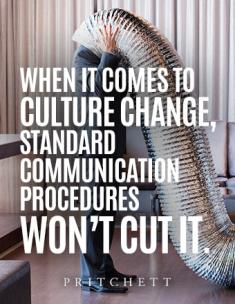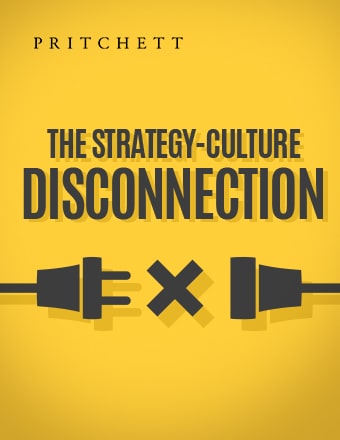You need a tremendous amount of high-quality communication to sustain a culture change. Managers typically underestimate the effort that is required. They rely on the normal communication practices and patterns, failing to consider that those methods were never designed for times like this. Standard communication procedures simply won’t cut it.
Consider the situation at hand. First, people need to hear the logic, the rationale, behind the decision to change the culture. Give them an airtight case, based on hard facts about the marketplace and the firm’s competitive position. Next, they want to know what’s coming, and how they’ll be affected personally. You must give them a clear understanding of what’s expected regarding new ways of work. You need to sell people on the purpose, preach hope, and explain the part they’re expected to play in the change strategy. The vision must be articulated, and then promoted with the zeal of a crusading evangelist.
And it doesn’t stop there. You can’t afford to let up. Don’t relax.
Talk up the new culture on every possible occasion—in meetings, memos, presentations, company publications, or the casual give-and-take of everyday interaction with others. Culture change needs lots of cheerleading.
Keep the dialogue going. Nonstop two-way communication is needed to offset the ambiguity, counteract the confusion, shift attitudes, and keep people on course. You can’t presume that your message stuck just because you said it more than once. Stress and confusion are distracting. People forget. Some don’t hear you in the first place. Others warp or deny messages. Information which is very familiar to you needs to be repeated time and again, more than you would ever believe is necessary.
You must get across to your people what management really wants. Employees are always struggling to sort out which ideas, plans, and instructions to take seriously. They can handle only so much. The question is, out of all the possible courses of action and things to do, what can they safely ignore? Management must send signals that are clear enough, strong enough, to make the company’s intentions clear.
Any communication gaps are going to cause you trouble. So don’t leave an information vacuum. Bad news, rumors, and worst-case thinking will fill the void. If you get lazy or careless about communication, employees will lose their bearings and the organization will start to drift. In that atmosphere the culture begins to revert back to its old ways.
Good communication can’t guarantee success in your efforts to change the corporate culture, but poor communication guarantees you’ll fail.





